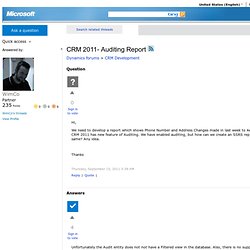

ActivityParty entity. Applies To: Microsoft Dynamics CRM 2013, Microsoft Dynamics CRM Online [This topic is pre-release documentation and is subject to change in future releases.]

An activity party represents a person or group associated with an activity. An activity can have multiple activity parties. In This Topic Activity Party Types There are 12 types of activity party in Microsoft Dynamics CRM. Activity Party Types available for each activity Not all activity party types are available for each activity in Microsoft Dynamics CRM, except for a custom activity. Kelvin's Blog: Crm 2011 Auditing Report. Unfortunately the Audit entity does not not have a Filtered view in the database.

Also, there is no support for advanced find and the like. Therefore there is no supported way to create a report that runs on the audit entity. If you are working with Dynamics CRM 2011 On Premise you could go for the unsupported solution provided by daemon lin in this thread: Query the table AuditBase (or the Audit view) in combination with the [MetadataSchema]. [Attribute] table and the [MetadataSchema]. [Entity] table to translate the AttributeMask (separated with ',') in AuditBase using Attribute.ColumnNumber = (the number in AuditBase.ChangeData), Attribute.EntityId = Entity.EntityId and Entity.ObjectTypeCode = AuditBase.ObjectTypeCode into the attribute names (You can get the display name using [MetadataSchema]. Note that security will NOT be applied on the data. Remember that in this case you are working in an unsupported mode and that a CRM update may break your report. How to remove a CRM user whose AD account has been deleted, disabled in CRM and ReAdd.
Hello Sixty4, Please have good backups of the MSCRM_CONFIG database before you do any direct database updates.

Go to Start | Run | type in CMD 2. Run ldp.exe 3. Select Connection -> Connect -> OK (no need to enter anything in for the Server value) 4. Select Connection -> Bind -> OK 5. This should return the canonicalName, ObjectGUID, and ObjectSID. For example... use MSCRM_CONFIG select * from systemuserauthentication where AuthInfo = 'W:S-1-5-21-2810021356-8860947-3055108156-1153' 10. Select * from Systemuser where ID = "UserID from step 9" If the user is in SystemUser and SystemUserAuthentication, it means they are in the table and you need to clear them out. Best regards, Don ChangPartner Online Technical Community ----------------------------------------------------------------------------------------- We hope you get value from our new forums platform! HOW TO: Relinking System User to AD User « CRM Codex. HOW TO: Relinking System User to AD User General HOW TO: Relinking System User to AD User Sometimes you may find yourself in a situation where a CRM system user record is no longer pointing to your Active Directory user.

This broken link basically prevents the user from accessing CRM! Not good! For our example lets say John the IT bod accidentally deleted the wrong Ad account of an active CRM user called Jane. Firstly check the CRM record of the broken user and note down the domain and username. Open up SQL Management Studio and within the Organisation tables that user was a part of, select the SystemUserBase table and choose to edit the rows.
Job Done! Share on facebookShare on twitterShare on emailShare on pinterest_shareMore Sharing Services 5 Comments John is cool. leave him alone Log in to Reply Another easy way to do this is to take his user record and change the domain name to a test user, save, then change it back. Leave a comment You must be logged in to post a comment. Microsoft CRM 2011 Timeouts and Limits - Yaniv Arditi. CRM 2011- Auditing Report. Unfortunately the Audit entity does not not have a Filtered view in the database.

Also, there is no support for advanced find and the like. Therefore there is no supported way to create a report that runs on the audit entity. If you are working with Dynamics CRM 2011 On Premise you could go for the unsupported solution provided by daemon lin in this thread: Query the table AuditBase (or the Audit view) in combination with the [MetadataSchema]. [Attribute] table and the [MetadataSchema]. Hans Linder on Microsoft Dynamics CRM: Principal Object Access Table - POA table grows large. In Microsoft Dynamics CRM 2011 there is a known performance issue when the POA table grow large.

Just the other day I was working with a customer to help them pin down why the POA table was so large in their organization database. We were also investigating if they could benefit from the use of Teams in CRM 2011 instead of using “share with users” as their POA table was growing a lot. If users frequently share records with other users you could benefit from setting teams as owners of those records instead. Or to have the users share with Teams instead of specific set of users. As we started our investigation we had a look at the POA table to see which objects they were sharing.The POA table stores information about records in CRM that is shared with other users or teams.